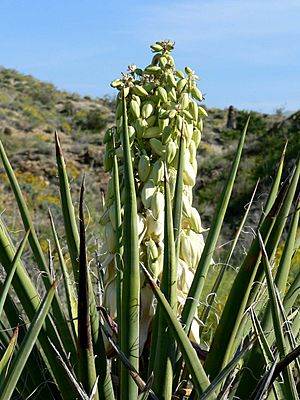Mojave yucca facts for kids
Quick facts for kids Yucca schidigeraMojave yucca |
|
|---|---|
 |
|
| Flowering plant, Palm Canyon, California | |
| Scientific classification | |
| Synonyms | |
|
The Yucca schidigera, often called the Mojave yucca or Spanish dagger, is a type of flowering plant. It grows naturally in the Mojave Desert, Chihuahuan Desert, and Sonoran Desert. You can find it in parts of southeastern California, Baja California, New Mexico, southern Nevada, and Arizona.
This yucca plant usually grows on rocky desert slopes. It also thrives in flat areas with creosote bushes. It prefers full sun and soil that drains water very well. This plant does not need extra water in the summer. It is related to the Banana yucca, which lives in the same areas. Sometimes, you can even find hybrid plants that are a mix of both.
Contents
What Does the Mojave Yucca Look Like?
The Yucca schidigera is a small evergreen tree. It can grow up to 5 meters (about 16 feet) tall. It has a thick top made of spiky, bayonet-like leaves. These leaves grow in a spiral pattern on top of a clear main trunk.
The bark of the trunk is gray-brown. Near the top, it is covered with dead brown leaves. Closer to the ground, the bark becomes rough and scaly. The leaves are long, from 30 to 150 centimeters (about 1 to 5 feet). They are 4 to 11 centimeters (about 1.5 to 4 inches) wide at their base. The leaves are thick, very stiff, and can be yellow-green or blue-green.
The flowers are white, sometimes with a hint of purple. They are shaped like bells and are 3 to 5 centimeters (about 1 to 2 inches) long. Rarely, they can be up to 7.5 centimeters (3 inches) long. The flowers grow in a tight, round cluster at the top of the stem. This flower cluster can be 60 to 120 centimeters (about 2 to 4 feet) tall. The fruit is a long berry, which can grow up to 11.5 centimeters (about 4.5 inches) long.
How is the Mojave Yucca Used?
Pollination and Plant Life Cycle
Moths play a special role in the yucca's reproduction. They collect pollen from the flowers. Then, they put this pollen onto another flower's stigma. The moth also lays its eggs inside the part of the flower that will become the fruit. As the fruit grows, the moth larvae eat some of the seeds. However, they always leave enough seeds for new plants to grow.
Traditional Uses by Native Americans
The Native Americans used the strong fibers from the Yucca schidigera leaves. They made these fibers into rope, cloth, and sandals. They also ate the flowers and fruit, either raw or cooked. The black seeds were ground into a flour for food. The roots of the plant were used to make soap.
Some stories say that Native Americans washed their hair with yucca. They believed it helped with dandruff and hair loss. This yucca was also used to help with headaches, bleeding, arthritis, and rheumatism.
Modern Uses of Yucca Extracts
Today, parts of this plant are used in different ways. Extracts from Yucca schidigera are added to animal feed. They are also found in various herbal medicines. The stiff flower stalk of the yucca, after it dries, can be used to make didgeridoos. These are musical instruments.
Yucca is also used as a natural deodorizer. You can find it in products that remove pet odors. Special natural substances called saponins are taken from Yucca schidigera. These can be used in food products. About a quarter of all dog food contains Yucca schidigera. It is mainly added to help reduce the smell of pet waste.
Scientists have also studied the effects of eating Yucca schidigera. They found it might lower blood cholesterol in humans and chickens. It could also help animals absorb vitamins and minerals better. Some research suggests it might even help cattle reproduce more.
How Fire Affects Mojave Yucca
When a fire happens, the Mojave Yucca can often grow new sprouts quickly. New seedlings also start to grow. The way fires spread in the desert depends on the plants that grow there. These plants act as fuel for the fire.
Over time, new types of grasses have been brought into the desert. These nonnative grasses can handle fire very well. They have caused fires to happen more often. This has changed the natural fire patterns that used to exist.
In the past, fires in the Mojave Desert were less frequent. They depended on winter rain. The Yucca schidigera was usually able to survive these fires. However, with more frequent fires caused by the new grasses, the survival rate of Yucca schidigera after a fire is now low. Most Yucca schidigera plants are damaged or killed by fire. There is little sign of the plant surviving after a fire.
See also
 In Spanish: Yuca de Mojave para niños
In Spanish: Yuca de Mojave para niños


